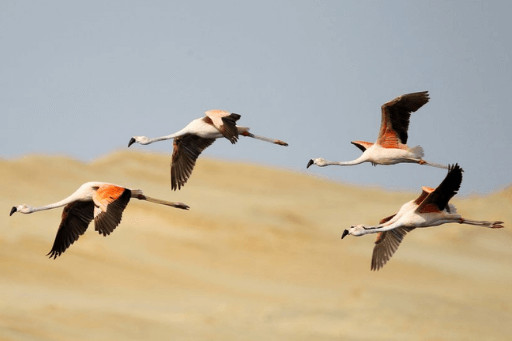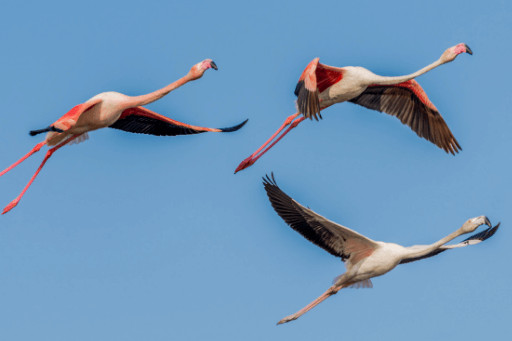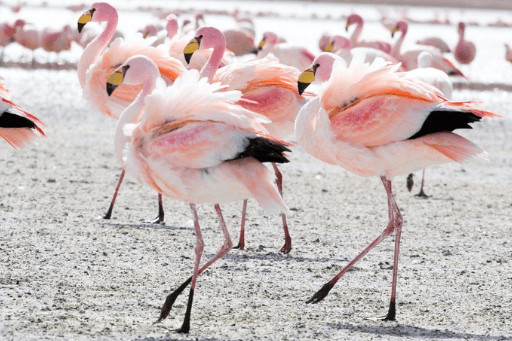Flamingos, with their striking pink plumage and graceful stature, often conjure images of exotic zoo exhibits or whimsical garden decorations. However, these magnificent birds are far more than just pretty faces. They possess a range of fascinating abilities, including the power of flight. Let’s delve into the aerial world of flamingos and uncover the truth behind their flight capabilities, destinations, and conservation status.
Yes, Flamingos Are Indeed Capable Flyers
Despite common misconceptions, flamingos are indeed capable of flight. The doubt often arises because flamingos in zoos frequently have their flight feathers clipped. This practice renders them flightless, preventing escapes from their enclosures. Globally, there are six distinct flamingo species, and each one is equipped for aerial journeys.
 Chilean Flamingos in flight. Photo by Mike Parr.
Chilean Flamingos in flight. Photo by Mike Parr.
Witnessing flamingos in flight is a truly breathtaking spectacle. These gregarious birds often take to the skies in flocks, soaring above serene waters that mirror their vibrant pink hues, creating an unforgettable visual experience.
Flamingos are surprisingly swift flyers. They can achieve speeds of around 35 miles per hour (mph) during shorter flights. When embarking on longer journeys, especially with favorable winds, they can reach impressive speeds exceeding 40 mph.
In flight, flamingos maintain a distinctive posture, extending their legs and necks straight out, often with their bills tilted slightly upwards. Their wings beat continuously, propelling them through the air. They skillfully utilize prevailing winds whenever possible, conserving precious energy during their flights.
How High Can Flamingos Ascend?
Flamingos are known to reach remarkable altitudes during their flights. Observations have documented them flying at elevations nearing 20,000 feet, particularly when traversing the towering Andes Mountains in South America. The altitude they attain is influenced by various factors, including wind direction and strength, as well as their intended destination. When flying across vast oceans, flamingos tend to maintain lower altitudes compared to flights over land.
Flamingo Migration and Flight Range
 Greater Flamingos in "V" formation. This species occurs in Eurasia and Africa. Photo by ananth-tp/Shutterstock.
Greater Flamingos in "V" formation. This species occurs in Eurasia and Africa. Photo by ananth-tp/Shutterstock.
Flamingo populations inhabiting temperate regions exhibit migratory behavior, seeking warmer climates outside their breeding season. For instance, the Andean Flamingo, which breeds in the high-altitude Andes, migrates to lower elevations along the Pacific coast for the winter. Flamingos are also known for their nomadic tendencies, roaming extensively in search of suitable wetlands that offer ample food resources. The American Flamingo, for example, can travel distances of up to 50 miles in pursuit of sustenance.
The Social Dynamics of Flamingo Flight
Flamingos are highly social birds, commonly observed in large flocks known as a “flamboyance.” When flying, they often adopt organized formations, typically flying in rows or the iconic “V” formation. This formation flight is an energy-efficient strategy. Each flamingo’s wing flap creates an updraft, providing lift to the birds following behind, making group travel less strenuous.
Flamingo Take-Off Techniques
Despite their substantial size, flamingos are adept at taking flight. They initiate take-off by running across land or shallow water while vigorously flapping their wings. When facing strong head winds, they can achieve lift-off with a single, powerful wing beat, showcasing their adaptability and strength.
Why Captive Flamingos Often Appear Flightless
As mentioned earlier, flamingos in zoos are frequently rendered flightless to prevent escapes. This is typically achieved by trimming their flight feathers. In some instances, more permanent and ethically debated methods are employed, involving alterations to tendons or bones in their wings. While considered inhumane by many, these permanent alterations are sometimes used in captivity due to their long-lasting effect.
Flamingo Flight Frequency
Flamingos are indeed frequent fliers in their natural habitats. They undergo molting, the process of shedding and regrowing feathers, gradually over extended periods. This ensures they retain their ability to fly throughout the year. However, in captive settings, and occasionally in the wild, flamingos may molt all their flight feathers simultaneously. During this period, they are temporarily flightless, usually for around three weeks, as new feathers develop.
Conservation Status of Flamingos
Sadly, several flamingo species are facing conservation challenges. Among the four flamingo species found in the Americas, three are experiencing rapid population declines. The Puna and Chilean Flamingos are classified as Near Threatened, while the Andean Flamingo is categorized as Vulnerable on the IUCN Red List. These majestic birds are primarily threatened by habitat loss and degradation resulting from coastal development and mining activities.
Additional threats to flamingos include oil spills and various forms of pollution. They are also vulnerable to collisions with power lines, particularly those erected near their foraging or nesting grounds. Furthermore, American Flamingos and their Caribbean habitats are increasingly susceptible to the impacts of sea-level rise and the intensifying storms driven by climate change.
 Puna or James's Flamingos. Photo by Curioso Photography/Shutterstock.
Puna or James's Flamingos. Photo by Curioso Photography/Shutterstock.
Conservation Efforts to Protect Flamingos
Organizations like the American Bird Conservancy (ABC) and other conservation groups are actively involved in safeguarding flamingo populations across various locations.
ABC has partnered with Aves Argentina to establish and expand a national park aimed at protecting Laguna Mar Chiquita, a vast salt lake in northern Argentina. This area is crucial for Chilean, Andean, and Puna Flamingos, particularly Chilean Flamingos, as it hosts up to a third of their entire population during certain breeding seasons.
ABC has also provided support to Asociación Ecosistemas Andinos (ECOAN), a Peruvian non-profit organization, in their efforts to conserve the Junín National Reserve in Peru, another vital breeding ground for Chilean Flamingos.
Through collaborative conservation initiatives, there is hope for the future of these incredible flying wonders.